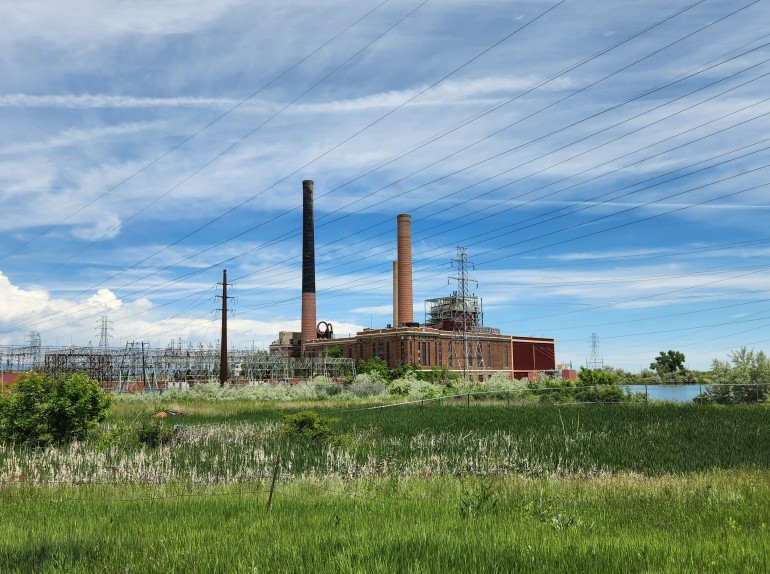
The Valmont Power Station has supplied power to Boulder since 1924, and for much of its history, its main fuel source was coal.
Xcel Energy, which owns the facility, officially stopped burning coal at the station in 2017. But the station’s 93 years of coal-burning operations created coal ash that now sits in multiple landfills on the property, and nearby groundwater has become contaminated. The energy utility plans to begin the first stages of coal ash remediation work next year — a project the company says could last more than a decade.
One landfill contains coal ash from just one of the station’s coal-powered units, Unit 5, produced from the mid-1980s through September 2018. The landfill followed Colorado state regulations, according to Xcel, but another, older landfill on the property was used before the regulated landfill.
Xcel aims to permanently close its regulated landfill, where coal ash sits beneath a layer of soil and vegetation. The energy utility is hiring a contractor, Charah Solutions of Louisville, Ky., to remove about 85% of the coal ash from the landfill and process it into a ready-mix concrete additive. Coal ash can be used in concrete as a partial substitute for cement, which is made from limestone.
The problem of managing coal ash isn’t unique to the Valmont station or to Boulder — according to the Environmental Protection Agency, coal ash is one of the largest streams of industrial waste in the U.S., and nearly 130 million tons of it were created in 2014 alone. Recycling coal ash into concrete binds the ash and helps prevent its constituents from leaching into the surrounding environment.
Coal ash, also known as coal combustion residuals, or CCRs, are made up of rocks, minerals, metals and other materials left over after the coal is burned, according to Xcel’s website. While these materials are found naturally in the soil, the ash can contain toxic contaminants such as mercury, cadmium and arsenic that need to be managed so they don’t pollute the water or air. And at least some of these contaminants don’t biodegrade.
In Boulder, Xcel’s own groundwater testing found levels of lithium and selenium exceeding groundwater protection standards in wells both on and near the Valmont property in 2020. Both substances are “potentially harmful if very large amounts are ingested,” Xcel’s website states, but there is “no evidence” of those substances infiltrating the city’s drinking water supply.
A 2023 city of Boulder Drinking Water Quality Report shows that city water did not exceed the maximum allowable limits for the constituents monitored from Jan. 1 to Dec. 31, 2022. The city is not required by the Colorado Department of Public Health and Environment to monitor all possible constituents every year, partly because the amounts of some constituents don’t fluctuate greatly from year to year and partly because the Boulder drinking water system isn’t considered susceptible to certain constituents.
Additionally, Boulder Communications Program Manager Cate Stanek said the city’s drinking water supply and its sources are “nowhere near (the Valmont Power Station).”
Reached for comment, Michelle Aguayo, a spokesperson for Xcel Energy, said protecting the environment and customers’ health and safety are priorities for the company.
“We continue to regularly monitor and test groundwater quality on the Valmont Station property and several nearby properties, following the process and steps outlined by the Environmental Protection Agency’s (CCR) Rule and state of Colorado regulations. EPA’s process includes taking additional steps to further investigate if we find constituents that exceed groundwater protection standards, and then proposing measures to correct the issue. Standards are set to protect public health, and exceeding a groundwater protection standard doesn’t mean there is a specific or immediate concern, only that more testing is needed.”
Additionally, Xcel Energy held a public meeting on May 23 to discuss the Valmont Station Coal Ash Recycling and Groundwater Action Plan and gather feedback from the community. The company is working with the EPA, the CDPHE and Boulder County to finalize its remediation plan, and will “continue to review comments from the public meeting,” Aguayo said.
Richard Mylott, a spokesperson for the EPA, confirmed his agency is monitoring Xcel’s work. He said facility owners are responsible for doing their own “investigation and cleanup actions with close oversight from federal, state and other applicable authorities.” So far, Mylott said, Xcel has made “satisfactory progress” in monitoring, investigating and assessing remedies for contamination,” but the EPA will continue to provide oversight.
Shawn Hollister, a spokesperson for Boulder County Public Health, said his agency is “coordinating with key stakeholders, including Xcel Energy and its regulatory partners, to ensure compliance with all local, state and federal requirements and best practices.”
The energy utility expects to start pumping and treating groundwater next year. Charah Solutions will begin setting up its operations next year, as well, and could start processing material as soon as the summer of 2025. The entire project could last up to 12 years.